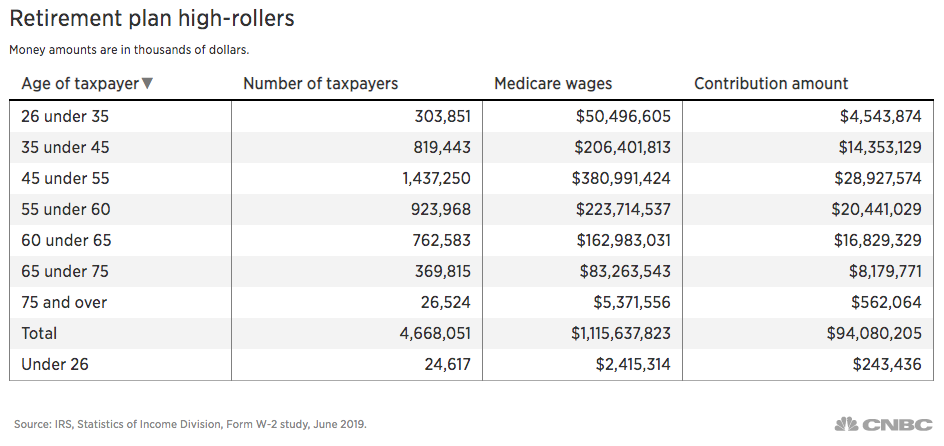Ezra Bailey | Getty Images
Stashing the maximum amount into your 401(k) plan is no easy feat — but a handful of taxpayers are making it work.
In all, more than 4.6 million taxpayers contributed the maximum amount in their 401(k) during the 2016 tax year, the latest data available from the IRS.
Back then, savers were able to sock away up to $18,000 in salary deferrals to their retirement plan, plus $6,000 if they were over 50.

Among the aggressive savers, the greatest concentration of them were in the 45 to 55 age group: More than 1.4 million taxpayers in that cohort put away the maximum in their accounts.
Though it may sound like a lot of people are putting away the maximum in their retirement plans, consider that the IRS received about 140 million returns in 2016.
“It’s a small drop in the bucket compared to the working population,” said Michael Landsberg, CPA and member of the American Institute of CPAs’ personal financial planning executive committee.
“This year, the maximum contribution is $19,000, plus $6,000 if you’re 50 and over — it’s a lot to defer and still have money left over for living expenses,” he said.
Managing competing goals
Jason York | Getty Images
Maxing out your 401(k) is an ideal goal, but it isn’t attainable for everyone.
For starters, when you save in your 401(k), you do so on a pretax basis and reduce your W-2 wages.
On the one hand, hefty contributions reduce your taxable income.
On the other, you’re also lowering your take-home pay, and that means you’ll have less cash for paying bills and attacking student loan debt if you have any.
“You don’t want to make decisions that are detrimental,” Landsberg said. “You’re paying off loans, you have credit card debt accruing – you don’t want to have too low of a take-home check.”
Striking a balance between the two can be difficult for employees, particularly when retirement plan service providers recommend that workers save at least 15% of their pretax income annually.
While this number sounds intimidating, it includes employer matches and profit sharing.
Be sure to save at least enough to get the match; it’s essentially free money.
To that end, while workers contributed a median 6% of their salary toward their 401(k) plans in 2018, the median contribution rate jumped to 9.8% when accounting for employer matches, Vanguard found.
Tax diversification
Saving in your 401(k) is a smart move, but you should resist the urge to sock away every spare cent into that account throughout your career.
That’s because withdrawals from your retirement savings plan and traditional individual retirement accounts are subject to income taxes and, if you take money out before age 59½, a 10% penalty.
Instead, by the time you’re retired, you’ll want to have savings in taxable accounts and Roth IRA and Roth 401(k)s, too.
Withdrawals from the Roth accounts are tax free because you paid taxes when you made conversions or when you converted amounts in your IRA to the Roth IRA.
By having a combination of taxable, tax-free and tax-deferred accounts, you’ll be able to manage your tax brackets and potentially save on Medicare premiums once you’ve retired.
“From a liquidity standpoint, you want to be aware of having a good mix of assets,” Landsberg said.
More from Personal Finance:
How much you’ll need to invest to retire with $1 million
This state is home to the best cities for renters
Parents exploit this loophole to secure more college financial aid
